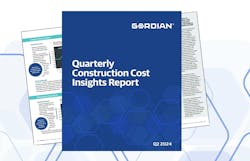Despite challenges, 2024 construction material prices continue to stabilize
By Gordian
While there are numerous global influences currently affecting the construction materials market, prices overall are stabilizing, according to Gordian’s latest report, Q2 2024 Quarterly Construction Cost Insights. International factors include the ongoing tensions in Ukraine and the Middle East, combined with the logistics impact of the recent collapse of the Francis Scott Key Bridge in Baltimore and increased traffic through the Panama Canal. The additional demand for materials as construction continues to rebound post-pandemic, as well as the current tight labor market, are also contributing to pricing volatility for certain commodities.
Partially offsetting these challenges is the trend of manufacturers to adopt near-shoring and reshoring strategies, allowing greater control of supply chains and moderating pricing fluctuations to some degree. Technology is also playing a significant role, with deep data analysis affording enhanced insights into costing and enabling improved procurement strategies.
Changes in methods of calculating labor costs
The report also details the “new normal” for calculating wages in construction. For all federally funded projects exceeding a contract value of $35 million, new Project Labor Agreements (PLAs) are estimated to increase construction worker wages by anywhere from 12% to 20%. In addition, the U.S. Department of Labor reworked the Davis-Bacon Act, a method used to calculate prevailing wages. This is also expected to increase the cost of labor, particularly in geographical areas with minimal union presence.
Gordian data is already reflecting the impact of these changes in the first part of 2024 for some worker categories, with labor costs trending upward in the structural, equipment, masonry, and mechanical trades.
Construction cost trends by material and geography
The full Gordian report details cost variability by major metropolitan areas in the U.S. and Canada, as well as by type of material. While costs trended lower in many parts of the U.S., particularly Utah and the Pacific Northwest, they rose in much of the southwest, especially in Colorado, Nevada, and Texas.
Analysis of specific materials shows the cost of framing lumber on par with 2023’s data, down from the pandemic-related spikes seen in 2021 and 2022. Likewise, conduit has remained consistent thus far into 2024 from its 2023 cost, this due to a surplus of aluminum from which it is made. Structural steel has stabilized with the pricing seen in mid-2023, but looks to be increasing slightly.
However, concrete block is volatile, having dropped in Q4 2023, but now on the rise. This is likely due to concerns about a cement shortage, a key ingredient of concrete. The price of copper electric wire has been trending upward as well, and is expected to continue to do so for the foreseeable future.
The full report provides detailed historical pricing data from Q1 2018 to the present for:
- Structural steel
- Framing lumber
- Concrete block
- Conduit
- Copper electric wire
- Fiberglass insulation
While pricing stabilization at a macro level is encouraging, there is still a degree of unpredictability and an overall upward creep that bears watching.
For the full analysis, including detailed pricing information and industry experts’ insights, download the complete Q2 2024 Gordian Quarterly Construction Cost Insights Report today.
